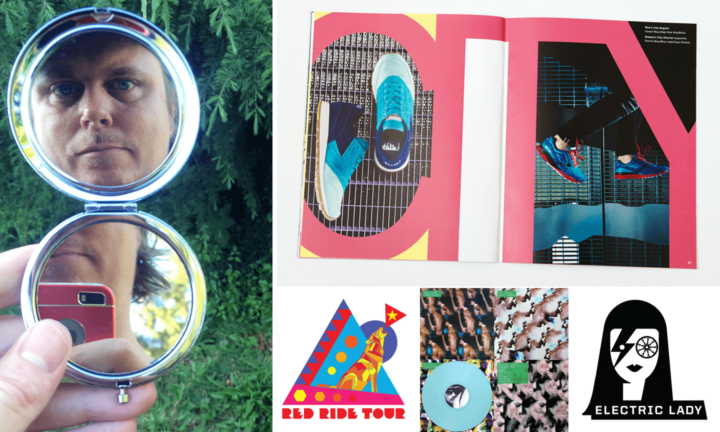Christian Petersen is a graphic designer, photographer, artist, journalist and curator. His multidisciplinary company I Want You Studio is best known for its innovative and unique approach to design and branding. Petersen recently became the Creative Director of the Seattle fashion store Baby & Co. Other clients include Mamnoon, Shabazz Palaces, Electric Lady Bicycles, The Office of Arts and Culture and Brooks and Perrier. Petersen partners with the dj Valerie Calano on Rare Air, a multi media club night of transcendental ambient music. He is currently co-producing (with Interstitial’s Julia Greenway) Imaginary Machine a large post-internet festival debuting in Seattle at the end of 2016. Petersen writes about digital art for ArtSlant magazine and also curates the online digital art gallery Digital Sweat.
Q: Design Change is…
A: The quality of design is currently measured by how much it appeals to other designers. Through rampant elitism and snobbery it has separated itself from it’s only natural purpose, to enhance, improve and inform the everyday lives of the general public. That must change.
Q: What’s the big opportunity for design in Seattle?
A: I feel like we’re at a crossroads in Seattle. The design establishment has long imposed a ‘tyranny of tastefulness’ that is hopefully is starting to crumble. I’m beginning to see small signs that making a statement (over adhering to the status quo) might be gaining traction. Hip Seattle design companies too often recycle slightly out of date global trends, passing them off an innovation and hoping nobody will notice. The only way we can compete as an global design city is to produce work that pushes boundaries globally. The colleges have a big responsibility in this. Instead of preparing students for a small local market they should be encouraging and inspiring real innovation that will have the chance to resonate beyond our insularity. Currently those working outside of the cliquey design establishment are producing the most interesting work but are generally ignored. It’s the responsibility of those commissioning design to recognize,encourage and support those designers.
Q: Is there anything specific to your design field that positions you to take a role in creating change?
A: I hope so! I am constantly trying to produce work that is personal to me while fulfilling the needs of the client. I despise trends in design and mistrust designers who embrace them just because that is the quickest path to success. I’m truly grateful that I’ve been able to support myself with my creativity since I moved here 10 years ago but it often hasn’t been easy. I’ve been lucky to find a few clients over the years that appreciated something a little different. I feel that recently there are more and more clients willing (and even eager) to take that chance. I would love to think that my path has ,or could, inspire others to forge their own path, but it’s not really for me to say whether that’s the case or not.
Q: What perspective change(s) do design professions (or your design profession) need?
A: There was a time when good design was basically universal and accessible to all. If you walked through a supermarket or flicked through a magazine in the 60’s, 70’s and 80’s the care and attention that went into designing mass produced items was staggering. Creative ideas were everywhere and could potentially inspire everyone. Then came a separation between the consumer and the designer. The marketing industry convinced Brands that good design was unnecessary (or even harmful) and designers retreated into a self obsessed bubble. Now ‘good design’ is available exclusively to the elite. Everyone else has to settle for whatever aesthetic crumbs trickle down. There is now very little middle ground between this elitist design and whatever horror that corporate brands would refer to as design. The notion of ‘expensive’ or ‘cheap’ is now imbedded in the design of a product. ‘Good’ and ‘Bad’ design are distinct signifiers of wealth and class which, in my opinion, is against everything that design should represent.
Q: What influences you outside of design?
A: All of my main influences come from outside of design and design that I am influenced by is rarely what would currently be considered ‘good’ design. The fact that the modern world of design is so self referential is a huge part of the problem. I think it would be a lot more interesting if designers looked beyond design as their primary source of inspiration. Or at the very least look beyond the current standard of “good’’ design which is usually based around accepted tastefulness rather than quality or innovation. A few old and new influences (off the top of my head) include Philip Lorca-diCorcia, Francesca Woodman, Dario Argento, Bobbie Gentry, Guy Bourdin, Radley Metzger, Earl Sweatshirt, Sly Stone, Suicide, Syd Barrett, The Runaways, Big Star, Weegee, Missy Elliot, Tom of Finland, Powell and Pressburger, Moebius, Kibbo Kift, Ghostface, New Kingdom, Star Trek Voyager, the movies Onibaba, Spirit of the Beehive and The Texas Chainsaw Massacre, the video games Bayonetta 2, Earthbound and Majora’s Mask.
Christian is participating in Design in Public’s Seattle Design Festival 2016: Design Change! Read about his program change.gif, an exhibition of GIFs that explores their potential to enact social change.





